Context:
The Prime Minister (PM) recently visited some famous temples in India ahead of the Ram temple ‘Pran Pratishtha’ ceremony in Ayodhya.
- The Ram temple in Ayodhya inaugurated on January 22 has been designed in the Nagara style of temple architecture.
About Ayodhya Ram Temple
- Layout of Ram Temple: The Ram Temple is built over three 20-foot high floors each with a total of 392 pillars and 44 doors in the complex.
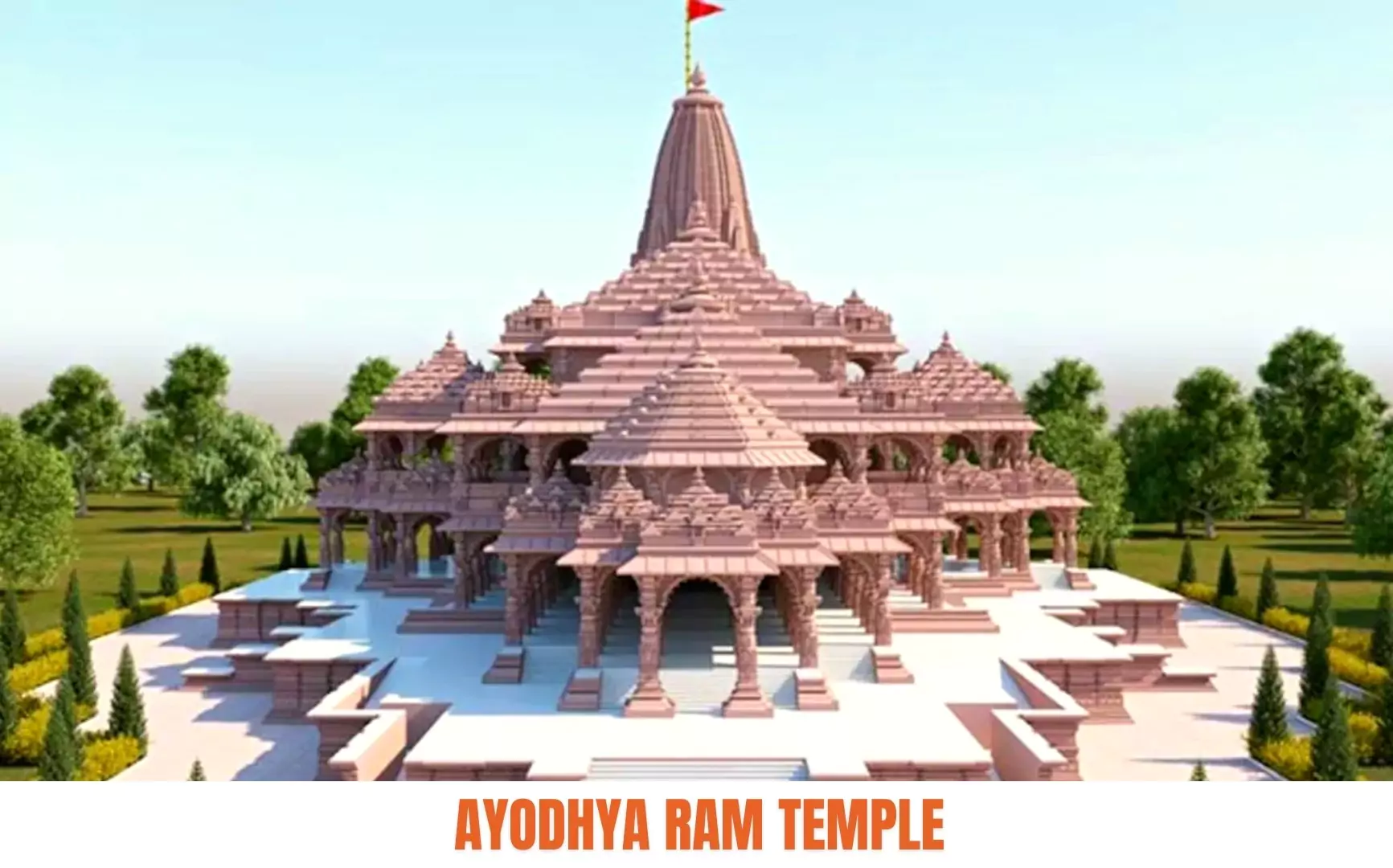 Foundation of the Ram temple: It is built of a 14-metre-thick layer of roller-compacted concrete and a 21-foot-high granite plinth has been placed to protect against ground moisture.
Foundation of the Ram temple: It is built of a 14-metre-thick layer of roller-compacted concrete and a 21-foot-high granite plinth has been placed to protect against ground moisture.- Iron has not been used anywhere in the construction.
- Stones used in Ram Temple: Makrana Marble and Pink sandstone, granite stone, and colored Marble.
- Sanctum Sanctorum (garbhagriha) of Ram Temple: Placed with the idol of Ram Lalla.
- Mandaps (halls) of Ram Temple: Nritya Mandap, Rang Mandap, Sabha Mandap, Prarthana Mandap and Kirtan Mandap.
Famous Temples in India Visited by The PM
-
Ranganathaswamy Temple in Tiruchirappalli, Tamil Nadu:
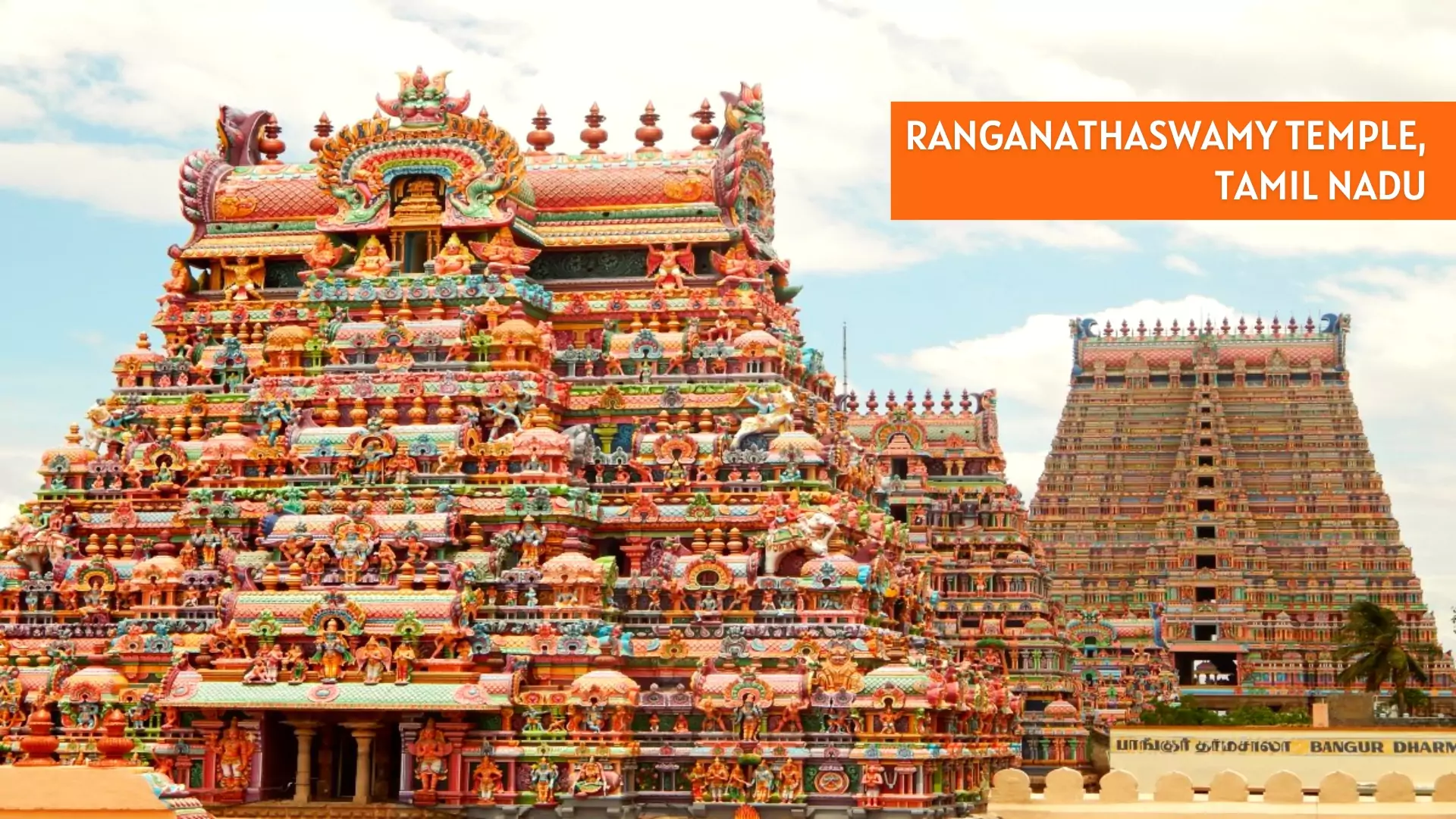
-
- Style of Architecture: It is one of the famous temples in India, Constructed in the Dravidian style of architecture.
- Principal deity: The main deity worshipped is Sri Ranganatha Swamy, a reclining form of Bhagwaan Vishnu.
- It is counted as the first and foremost among the 108 Divya Desams dedicated to Bhagwan Vishnu.
- Location: It is situated on the island of Srirangam which is bounded by the two rivers of Cauvery and Kollidam (a tributary of Cauvery).
-
Sri Arulmigu Ramanathaswamy Temple, Rameshwaram:
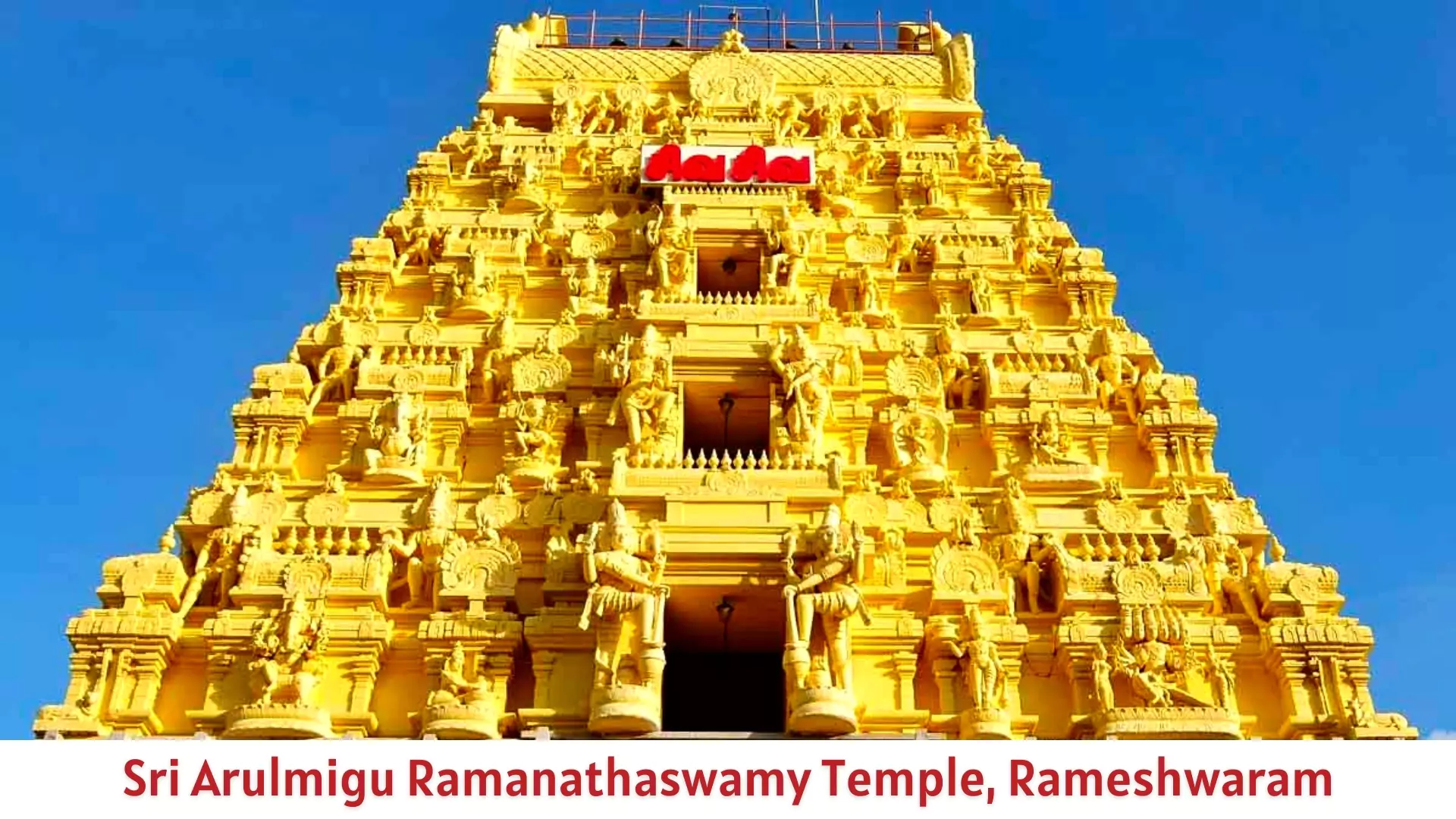
-
- Style of Architecture: It is one of the famous temples in India and It is Dravidian style temple and the temple complex is covered by a compound wall (thiru mathil).
- Principal Deity: The main deity worshipped in this temple is Sri Ramanathaswamy, which is a form of Bhagwan Shiva.
- Location: It is located in Rameshwaram, which is a small island connected to the mainland via Pamban Bridge.
- Mythology: It is believed that the main lingam in this temple was installed and worshipped by Sri Rama and Mata Sita.
- It is one among the Char Dhams – Badrinath, Dwarka, Puri and Rameshwaram and is one of the twelve jyotirlinga temples in India.
-
Shree Ramaswami Temple in Thriprayar, Kerala:
-
- Style of Architecture: It is also one of the famous temples in India, and constructed in the Dravidian style of architecture.
- Principal Deity: Thriprayar Ramaswamy Temple. also known as Triprayar Temple, is dedicated to Lord Rama.
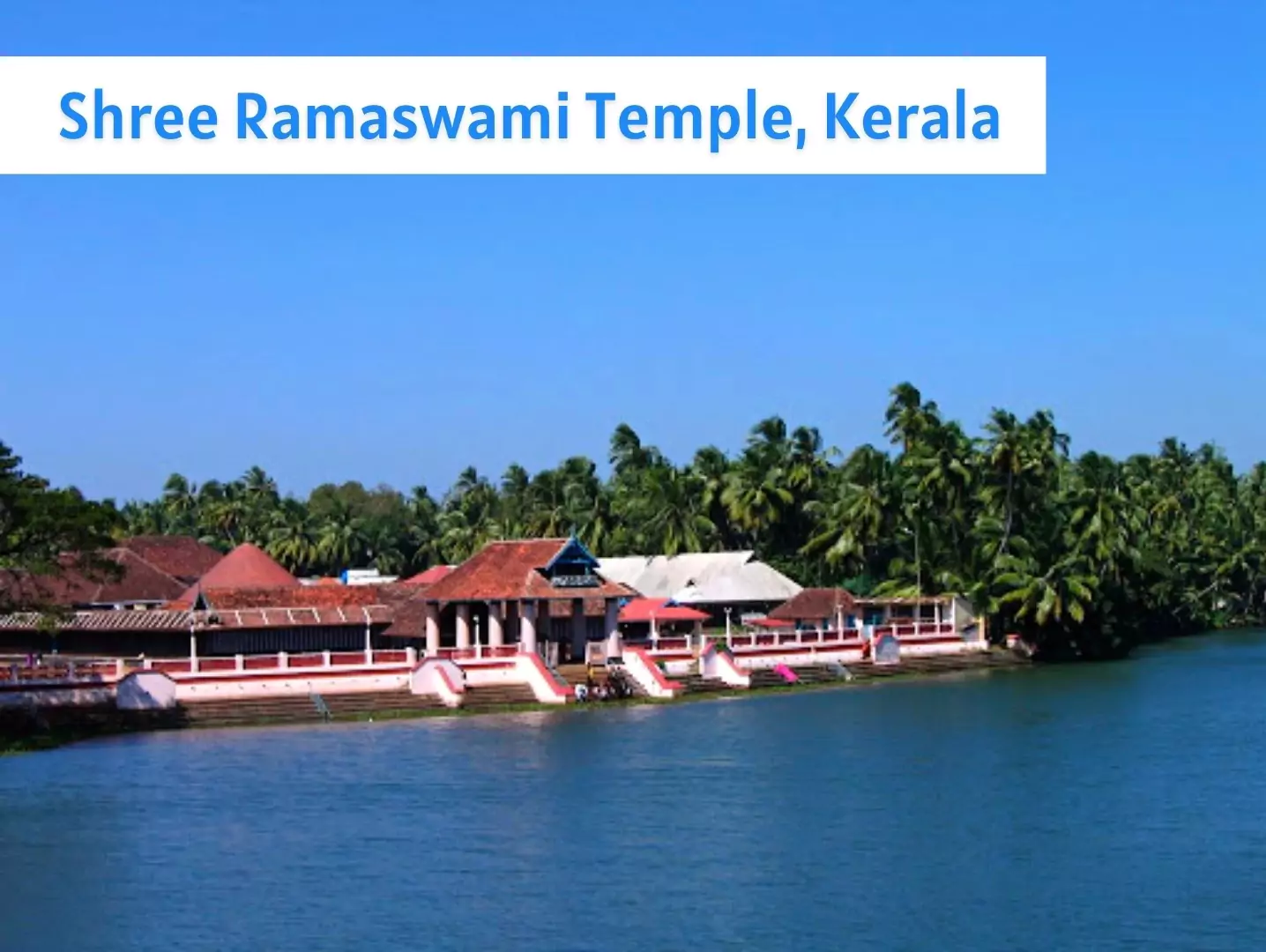 The image of Rama (Triprayar Thevar) resembles the Chaturbhuja Vishnu form with four arms, bearing a conch(Panchajanya), a disc (Sudarsana), a bow (Kodanda) and a garland respectively.
The image of Rama (Triprayar Thevar) resembles the Chaturbhuja Vishnu form with four arms, bearing a conch(Panchajanya), a disc (Sudarsana), a bow (Kodanda) and a garland respectively.
- Location: It is located in Thrissur district of Kerela on the bank of river Theevra.
- Theevra river is also called Purayar. Hence, it got the name Thirupurayar (sacred river) and later became Triprayar.
- Nalambala Dharshan: It is one of the four temples in the Nalambala Dharshan (four-temple pilgrimage) where devotees take a pilgrimage to four temples devoted to Rama, Lakshmana, Shatrughna and Bharatha during the month of Karkidakam, also known as month of Ramayana.
- Mythology: It is believed that the idol kept at the Thriprayar temple was worshipped by Lord Krishna in Dwaraka.
- It was submerged in water when Dwaraka was flooded after Krishna’s death. The idol, which was found later, was consecrated at Thriprayar.
-
Guruvayur Temple in Kerala:
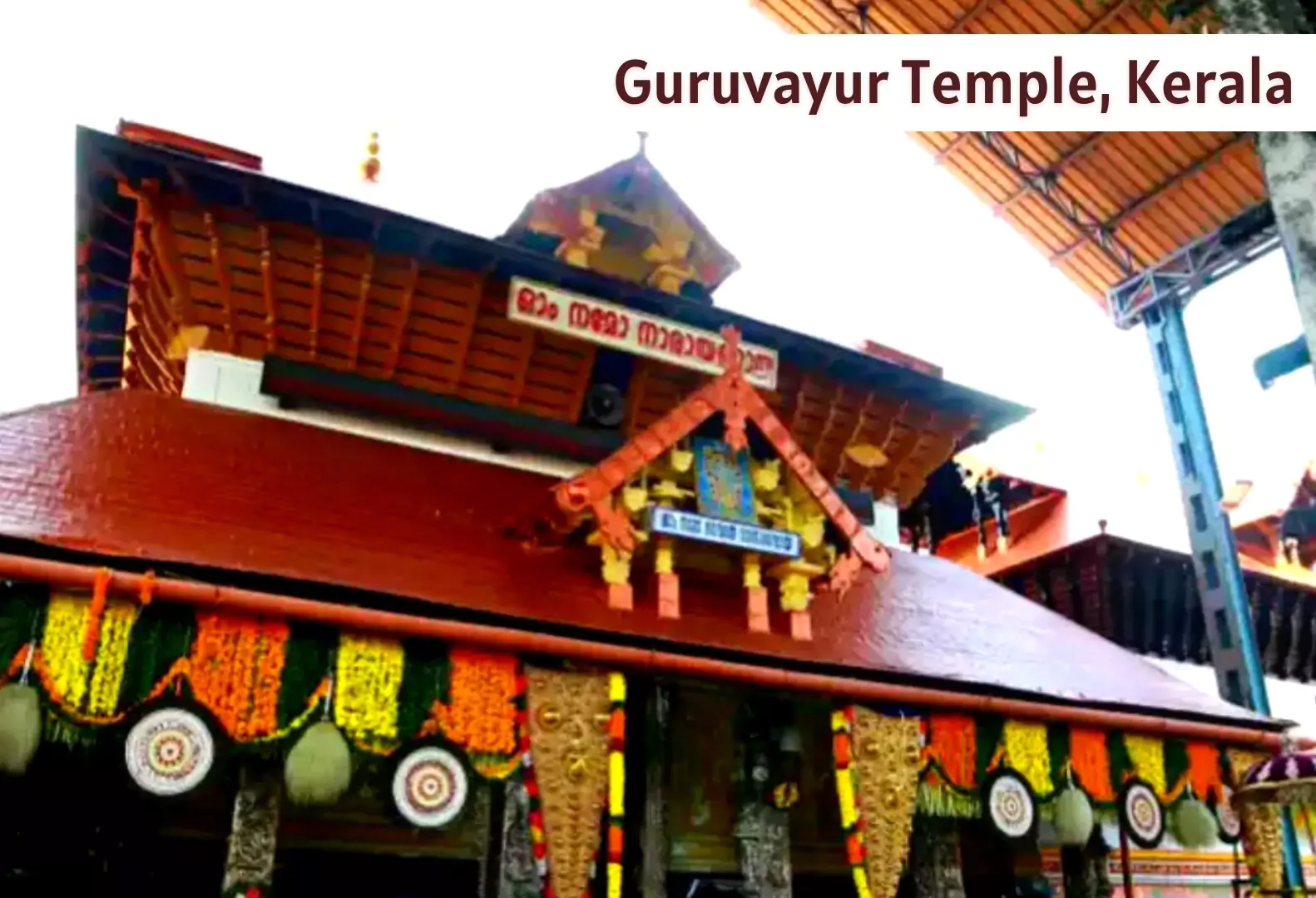
-
- Style of Architecture: It is one of the famous temples in India, and It is blend of Kerala and Chola dynasty temple architecture.
- Location: Located in the Guruyaur Town in Thrissur district, the temple is also known as the Dwarka (birth place of Lord Krishna) of the South.
- Principal Deity: The temple, dedicated to Lord Vishnu and the young form of Lord Krishna, is also known as Guruvayur Sree Krishna Temple. The temple is therefore also called Guruvayur Sri Krishna temple.
- The Guruvayoor form of Lord Vishnu has four arms. One has the conch Panchajanya, another has a discus Sudarshana Chakra, the third one has the mace Kaumodaki and the fourth is holding a lotus with a Holy basil garland.
- Elephant Festival: The temple is also known for its elephant festival where magnificently dressed elephants are paraded for various performances.
- The temple is home to a large population of captive male Asian elephants.
- The Punnathur Kotta elephant sanctuary is located nearby the temple.
-
Kothandaramaswamy Temple in Dhanushkodi (Tamil Nadu):
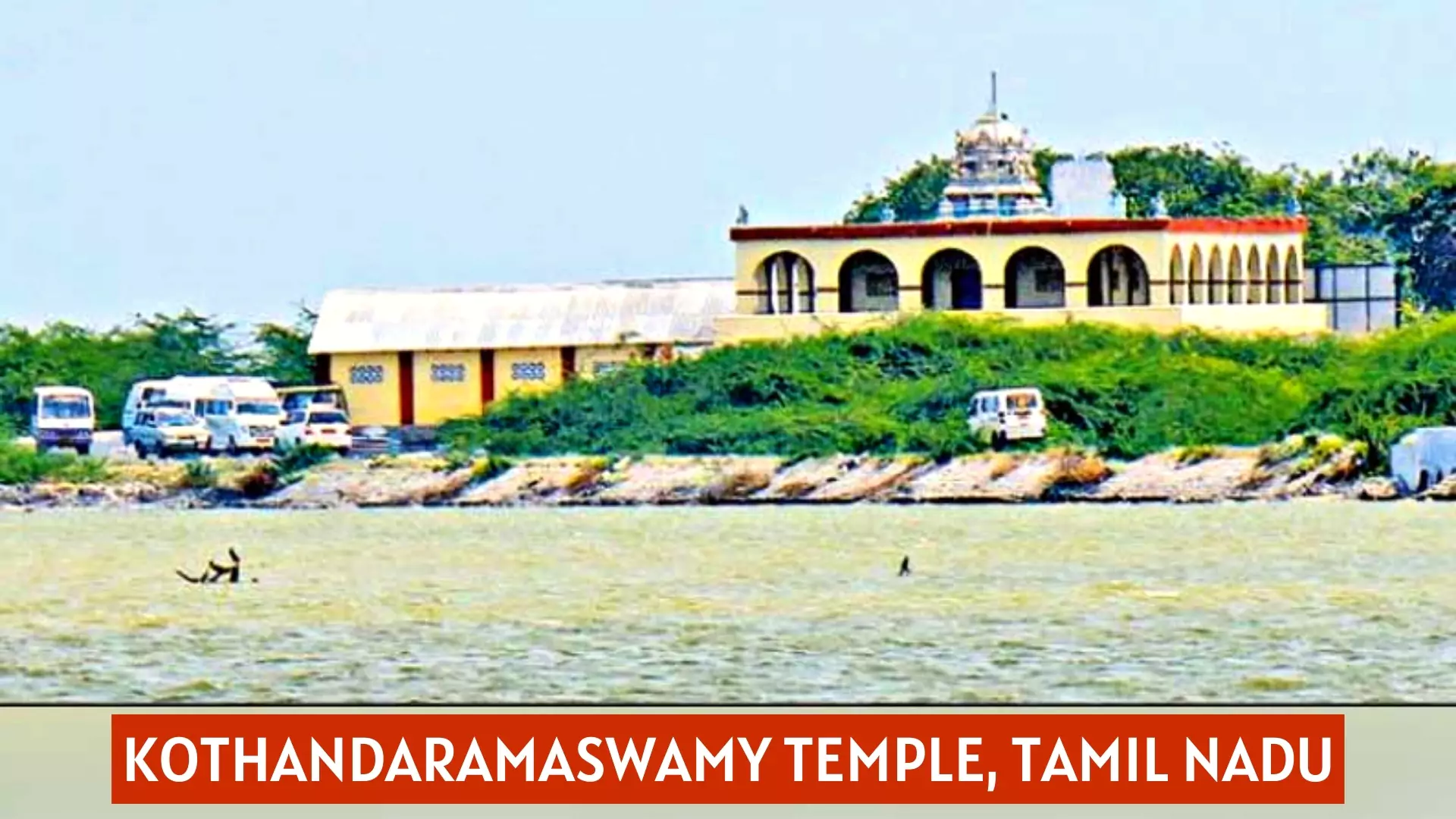
-
- Principal Deity: It is also one of the famous temples in India and is dedicated to Sri Kothandarama Swamy. The name Kothandarama means Rama with the bow.
- Location: It is located in Dhanushkodi. on Rameswaram Island at a distance of 12 km from Rameshwaram’s main town.
- Mythology: It is believed that Ravana’s brother Vibhishana first met Lord Ram and sought refuge here.
-
Veerabhadra Temple, Lepakshi, Andhra Pradesh:
-
- Principal Deity: Veerabhadra Temple is one of the famous temples in India and is dedicated to the Virabhadra, a fierce incarnation of Lord Shiva.
- Location: The Veerabhadra Temple, also known as the Lepakshi Temple, is located in Andhra Pradesh’s Lepakshi.
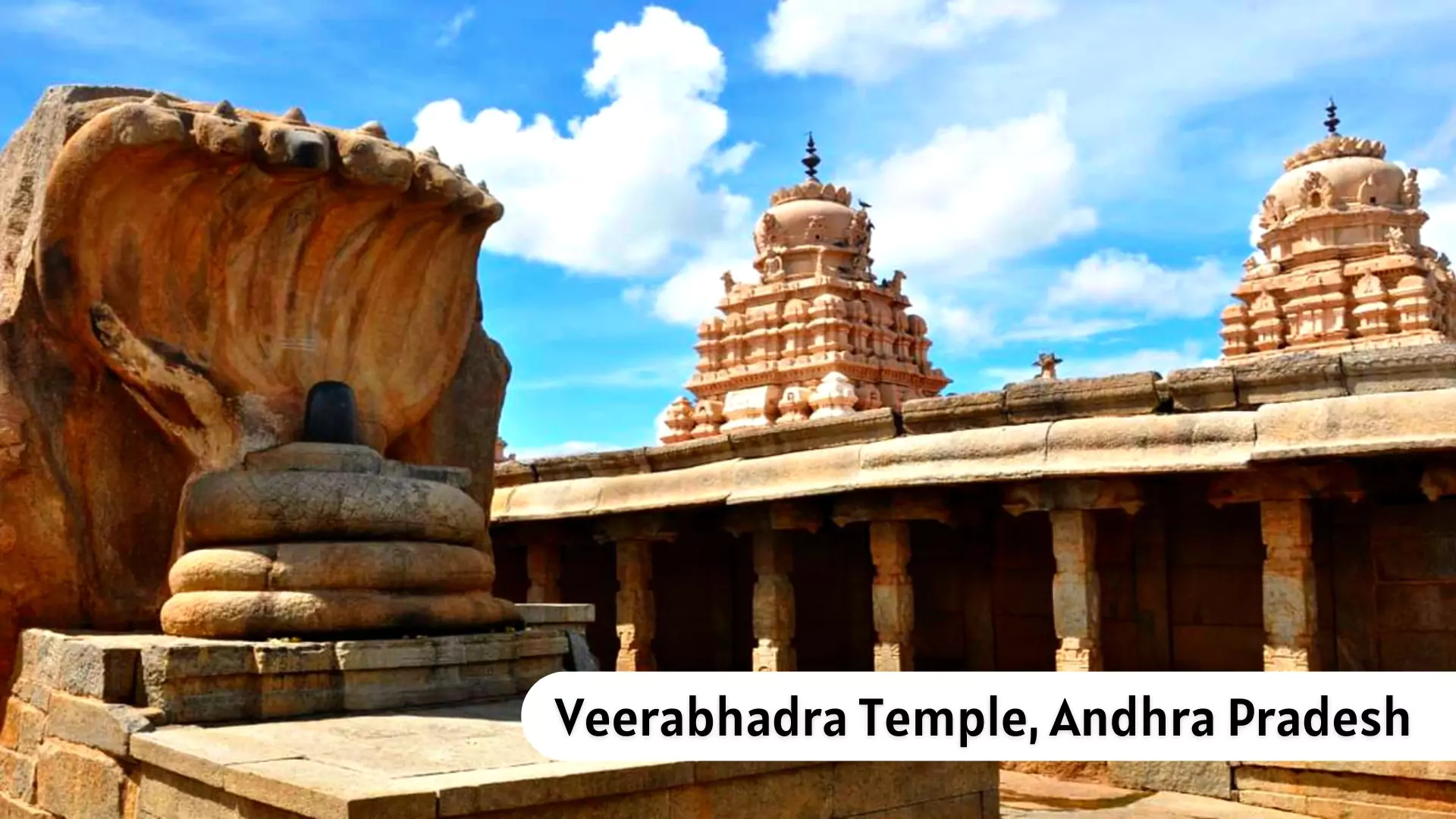 Temple Construction: The temple was built in 1533 AD by Virupanna Nayaka and Vienna, who were governors under the Vijayanagar empire during the reign of king Achutaraya.
Temple Construction: The temple was built in 1533 AD by Virupanna Nayaka and Vienna, who were governors under the Vijayanagar empire during the reign of king Achutaraya. - Fresco Painting: It is famous for frescoes and murals. There is a fresco of the fourteen avatars of Lord Shiva (one of them being Veerabhadra) on the ceiling.
- Nandi Bull: Nandi is a gigantic bull sculpture carved out of a huge granitic rock.
- It is located about 200 meters away from the temple. It is carved from a single block of stone.
- Association with Ramayana: The temple is closely associated with the Ramayana. It is believed that the bird Jatayu, fell at the place after being fatally wounded by Ravan.
- It has been placed on the tentative list of the World Heritage Committee.
-
Kalaram Temple, Nasik (Maharashtra):
-
- Principal deity: The Kalaram temple is one of the famous temples in India and its name derives from a black statue of the Lord — Kala Ram.
- The sanctum sanctorum has statues of Ram, Sita, and Lakshman, and a black idol of Hanuman at the main entrance.
- Location: It is situated on the banks of the Godavari river in the Panchavati area of the city.
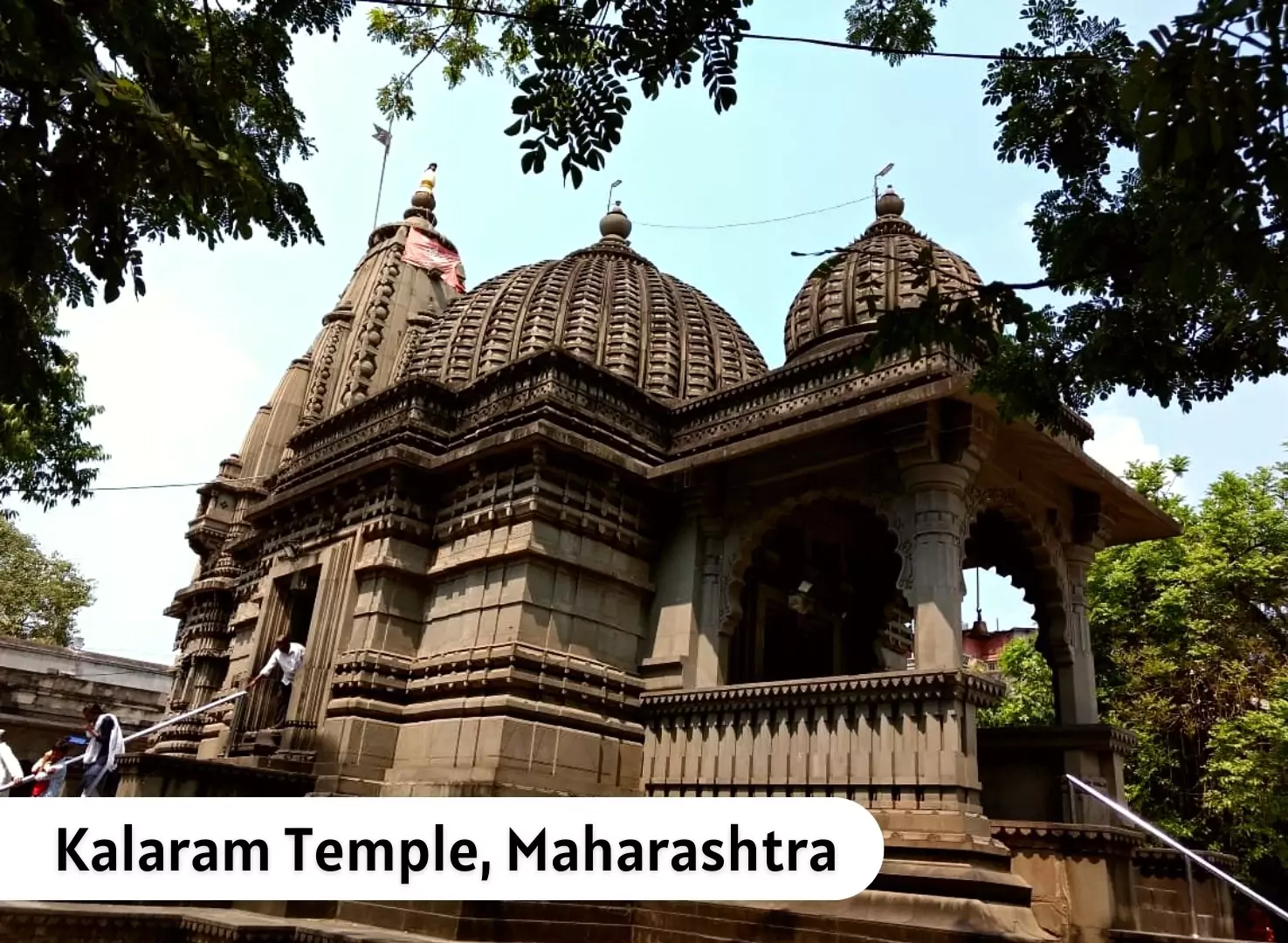 The name Panchavati comes from the existence of five banyan trees in the area.
The name Panchavati comes from the existence of five banyan trees in the area.
- Built by: The Temple was built in 1792 by Sardar Rangarao Odheka.
- Mythology: It is believed that Lord Ram lived in Panchavati.
- Place of Dalit Satyagraha: In 1930, B R Ambedkar and the Marathi teacher and social activist Pandurang Sadashiv Sane, known as Sane Guruji, led an agitation to demand access for Dalits to Hindu temples.
Temple Architecture in India
Three Main Temple Architecture Found in India, Which are;
- Nagara Style
- Dravida Style
- Vesara Style
Nagara Style or North Indian Temple Style
This architectural style of temples gained popularity in northern India around the fifth century CE, during the late Gupta period. Its features include:

- Raised Stone Platform: These were constructed on a stone platform with steps leading up to it.
- Lack of Boundary Walls or Gateways: Usually, they do not have elaborate boundary walls or gateways.
- Sanctum (Garbhagriha): Initially a small cubicle with a single entrance, the sanctum evolved into a larger chamber over time. It is designed to house the main icon.
- Entrance (Mandapa): The entrance to the temple, whether a portico or collonaded hall, serves as a space for accommodating many worshippers.
- Shikhar: The temples used to have mountain-like spires, which can take the shape of a curving shikhar.
- The vertical end of the shikhara ended in a horizontal fluted disc, known as amalaka. On the top of that, a spherical shaped structure called Kalash is placed.
- Example: Dashavatara temple, Deogarh
The Dravida Style or South Indian Temple Style
These In South India, the most famous temples are built in the Dravidian style characterized by stone structures, towering spires, intricate sculptures, and detailed inscriptions. Its features include:
- Gopurams: The frontal wall features a central entrance gateway, commonly known as a gopuram.
- Compund Walls: In contrast to the nagara temple, the dravida temple is surrounded by a compound wall.
- Water Tanks: Temple complexes often include large water reservoirs or temple tanks.
- Vimana: The main temple tower, referred to as vimana in Tamil Nadu, has a stepped pyramid shape that ascends geometrically, distinct from the curving shikhara seen in North Indian temples.
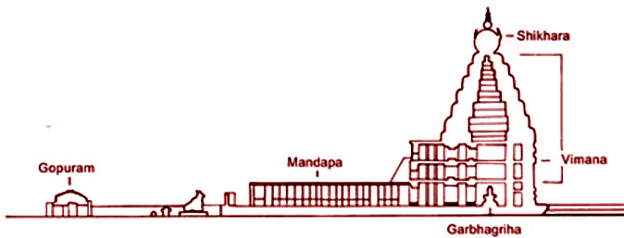
- Shikhar: In South Indian temples, the term ‘shikhara’ is specifically used for the crowning element at the pinnacle of the temple.
- This element is typically shaped like a small stupika or an octagonal cupola, equivalent to the amlak and kalasha found in North Indian temples.
- Temple Shapes: Dravida temples are categorised into five shapes: Square (kuta or caturasra), Rectangular (shala or ayatasra), Elliptical (gaja-prishta or vrittayata), Circular (vritta), and Octagonal (ashtasra).
- Example: Gangaikondacholapuram temple
Vesara Style
Vesara style temple architecture in the Deccan region, particularly in Karnataka, is known as the Vesara style. It exhibits a blend of North and South Indian influences. Important features include:
- Open ambulatory passageway with pillars, doorways and ceilings decorated with intricate carvings.
- Dravidian influence is seen in intricate carvings and sculptures.
- Nagara influence is seen in the curvilinear shikhara and the square base of temples.
- Example: Virupaksha temple, Pattadakal
Major UNESCO Temples in India: List
Khajuraho Temple
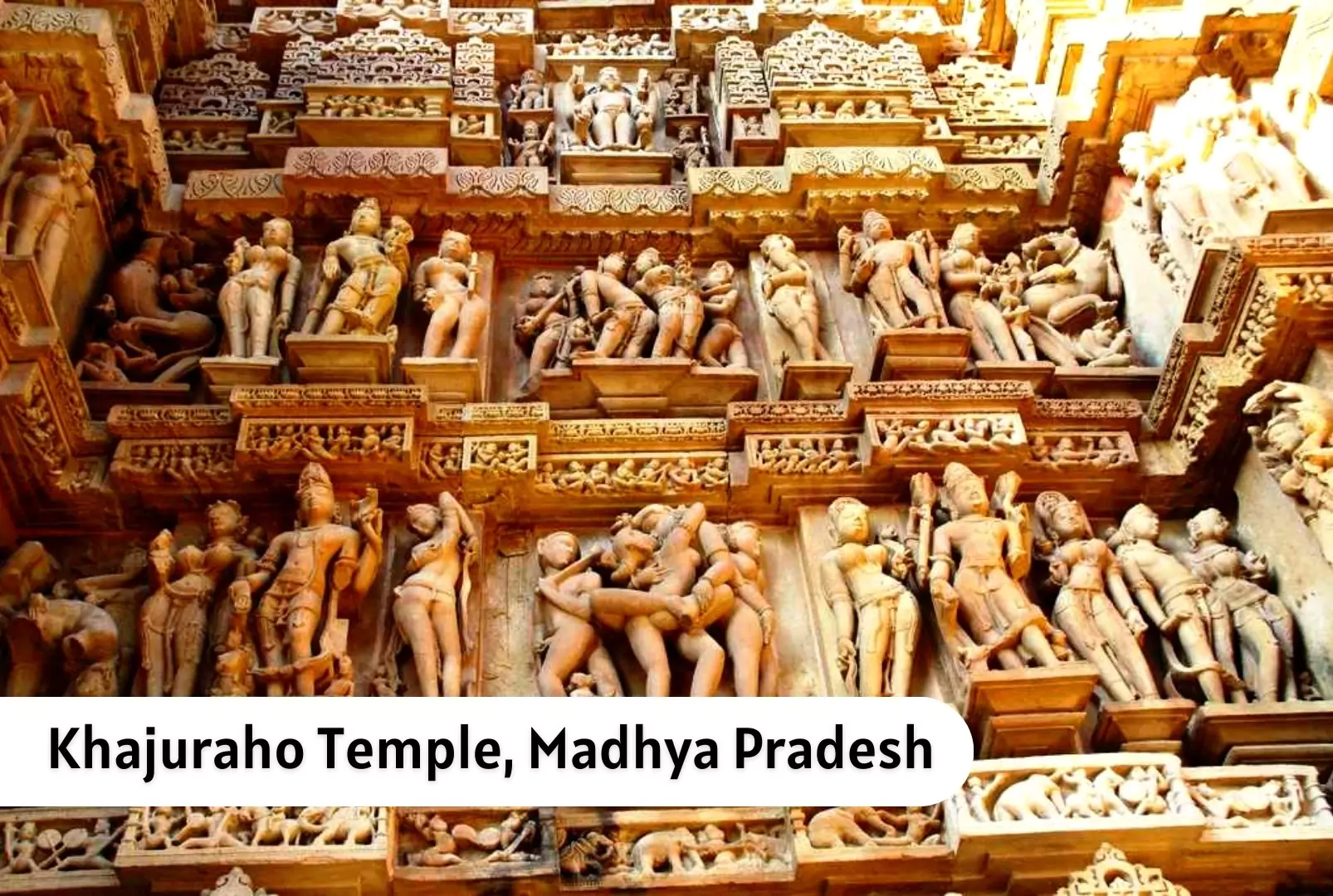
|
- About: It consists of a total of 85 Temples spread across an area of 20 square kilometres.
- Location: Khajuraho, Madhya Pradesh
- Temple Style: Nagara style and erotic figures and sculptures.
- Dynasty: Most of these monuments were built between 950 to 1050 CE under the reign of the Chandella dynasty.
- Religion: Renowned for a group of Hindu and Jain Temples situated 175 km south-east of Jhansi.
- Most prominent Temple: The Kandariya Mahadeo temple
|
Sun Temple, Konark, Odisha
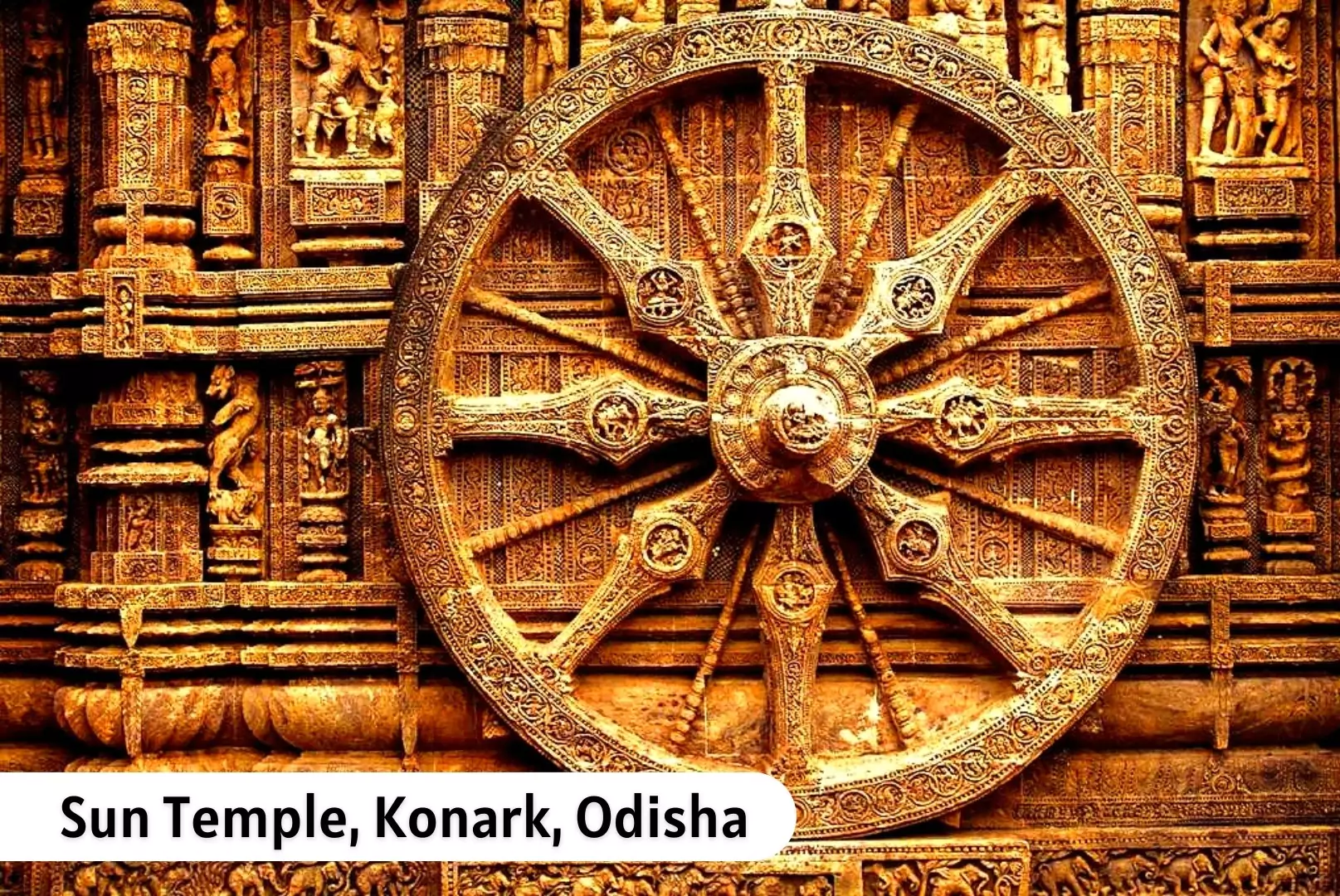
|
- Also known as Black Pagoda, Chariot of the Sun, Kalinga Architecture, Included in Seven Wonders of India.
- About: The Sun Temple is in the shape of a gigantic chariot with carved stone wheel, pillars and walls and is led by six enormously carved horses.
- Dynasty: It was built by King Narasimhadeva I of the Eastern Ganga Dynasty in around AD 1250.
- Temple Style: Kalinga Architecture
|
Hoysala Temples, Karnataka – the Sacred Ensembles of the Hoysala
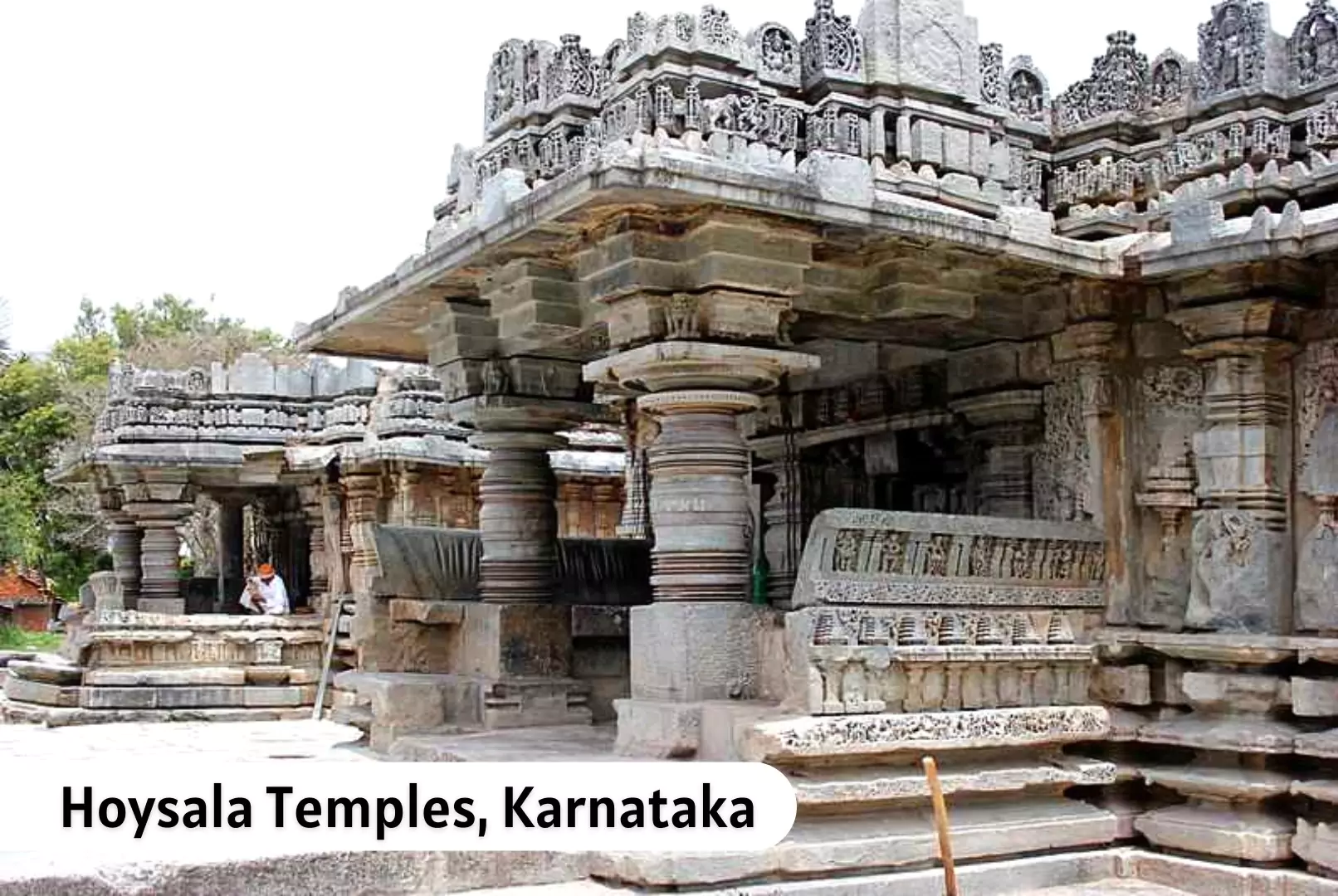
|
- Dynasty: Hoysala Temples constructed during the reign of the Hoysala dynasty between the 11th and 14th centuries.
- Location: Predominantly found in the Malnad regions of Karnataka.
- Temple Style: Unique architectural style, characterized by star-shaped platforms and ornate pillar designs.
- Important Temples: Chennakesava Temple in Belur and the Hoysaleswara Temple in Halebidu.
|
Chola Temples
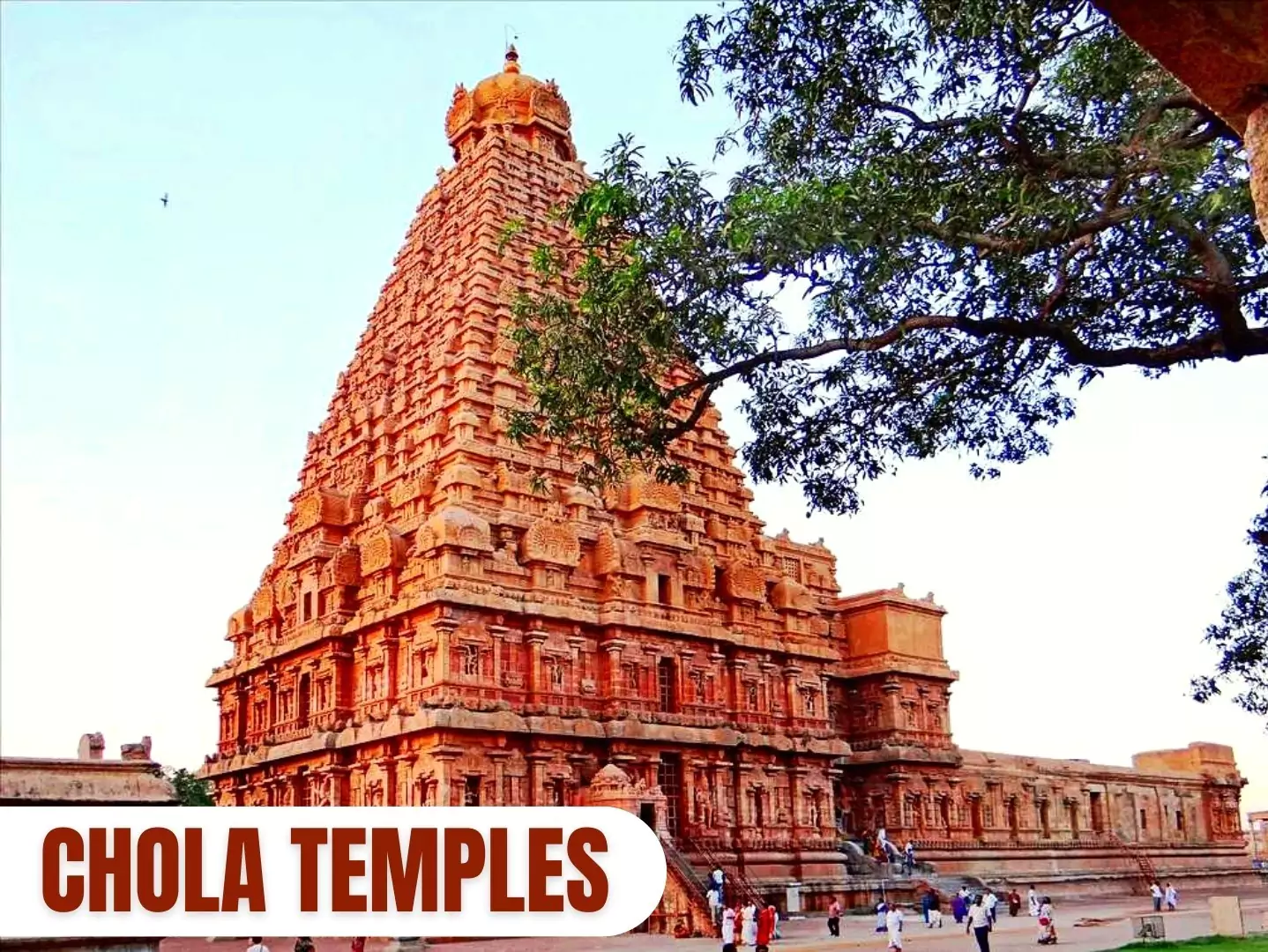
|
- Includes: Brihadisvara Temple, Thanjavur, Brihadisvara Temple, Gangaikondacholisvaram and Airavatesvara Temple, Darasuram.
- Famous as: Chola Architecture, Sculpture, Painting and Bronze Casting.
- Dynasty: Chola empire.
- The Brihadisvara temple was built under the reign of Rajaraja 1 and is a milestone of Chola architecture.
- The temple at Gangaikondacholapuram was patronised by Rajendra 1 and was dedicated to Lord Shiva.
- The Airavatesvara temple was built during the time of Rajaraja II.
- Chola Living Art: These temples are living temples and the rituals and festivities which were observed by people thousands of years ago, are still held.
- Hence, these three temples reflect the ancient culture and form an inseparable part of their ancient history.
|
Group of Monuments at Mahabalipuram, Tamil Nadu
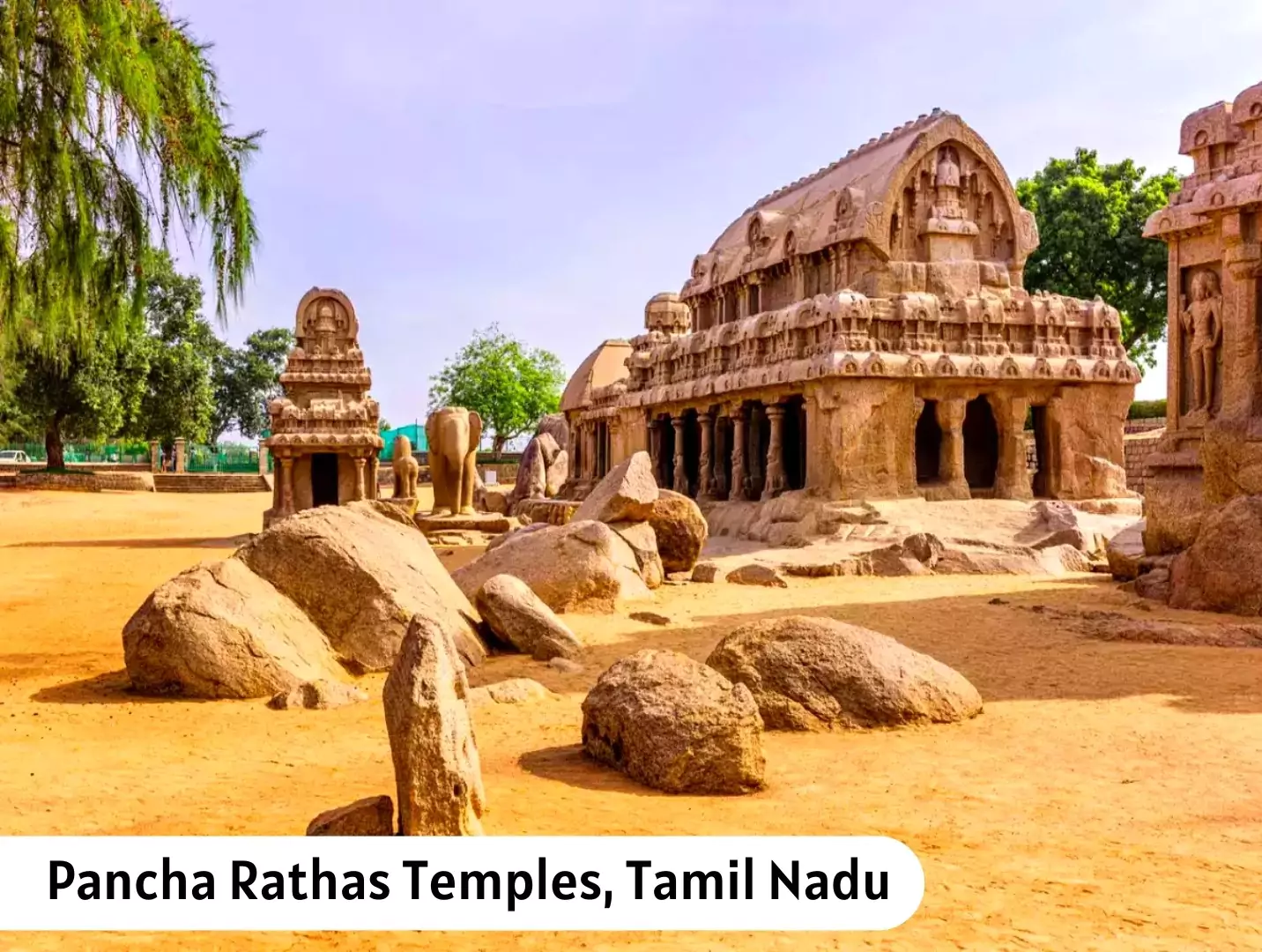
|
- Includes: The Pancha Rathas Temples, Ganesha Ratha, Cave Temples of Mahabalipuram, Structural Temples including the Shore Temple and the Olakkannesvara Temple and the Descent of the Ganges.
- Dynasty: These temples were built under the reign of the Pallava rulers.
- Rock-cut Architecture: They are all carved out of a single rock and are important in terms of Ratha architecture in India.
|
Group of Monuments at Pattadakal, Karnataka
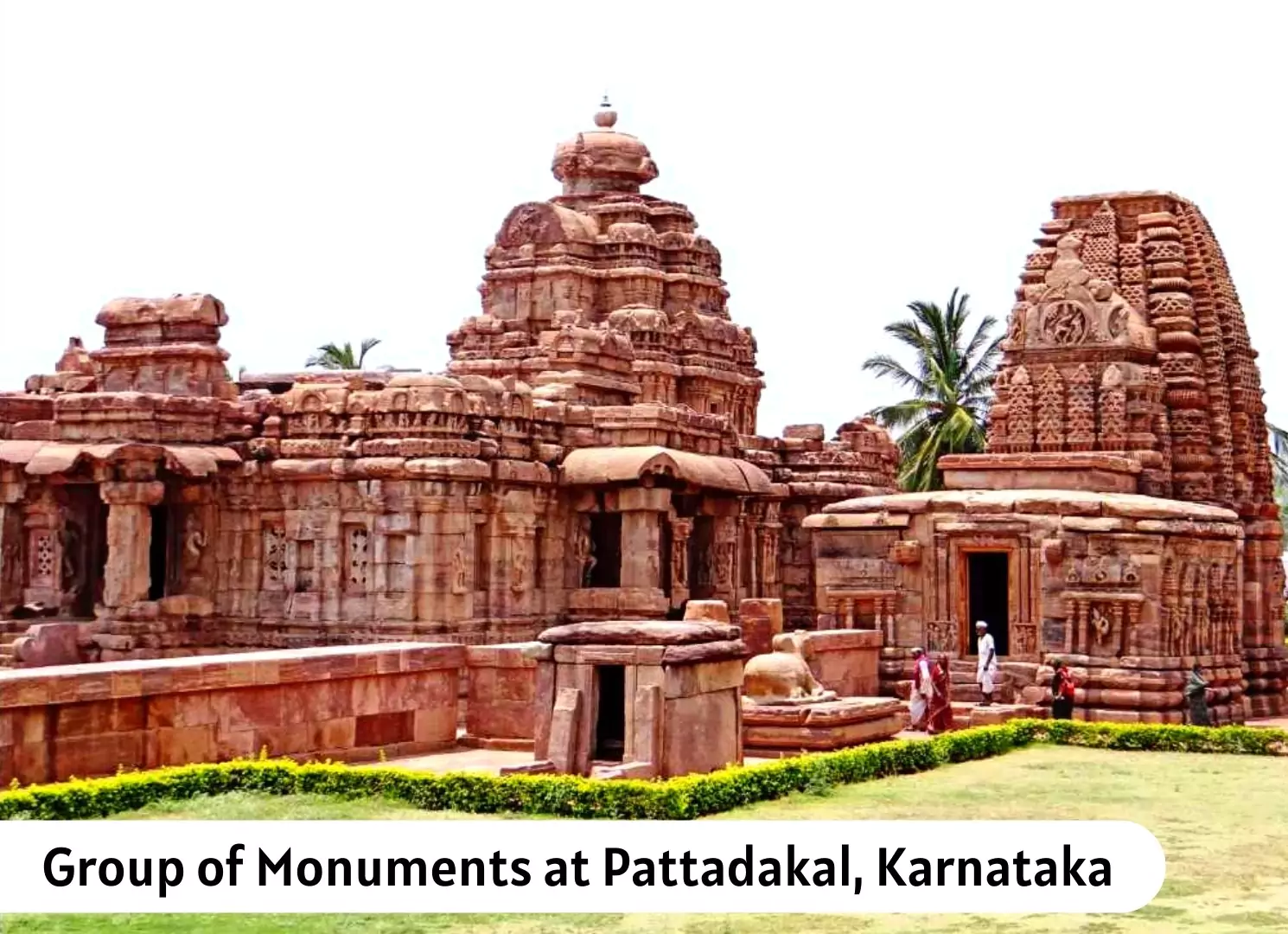
|
- About: It includes eight temples dedicated to Lord Shiva and Jain and Shaivite sanctuaries.
- Temple Style: It is famous for its Chalukya style of architecture that originated in Aihole and blended with the Nagara and Dravidian styles of architecture.
- Famous monuments: Virupaksha Temple, Sangameshwara Temple, Chandrashekhara Temple, MallikarjuTemple, Kashi Vishwanath Temple, Jagannath Temple, Jain Temple and many more.
|
Also Read: Jagannath Temple Beautification Project
![]() 22 Jan 2024
22 Jan 2024
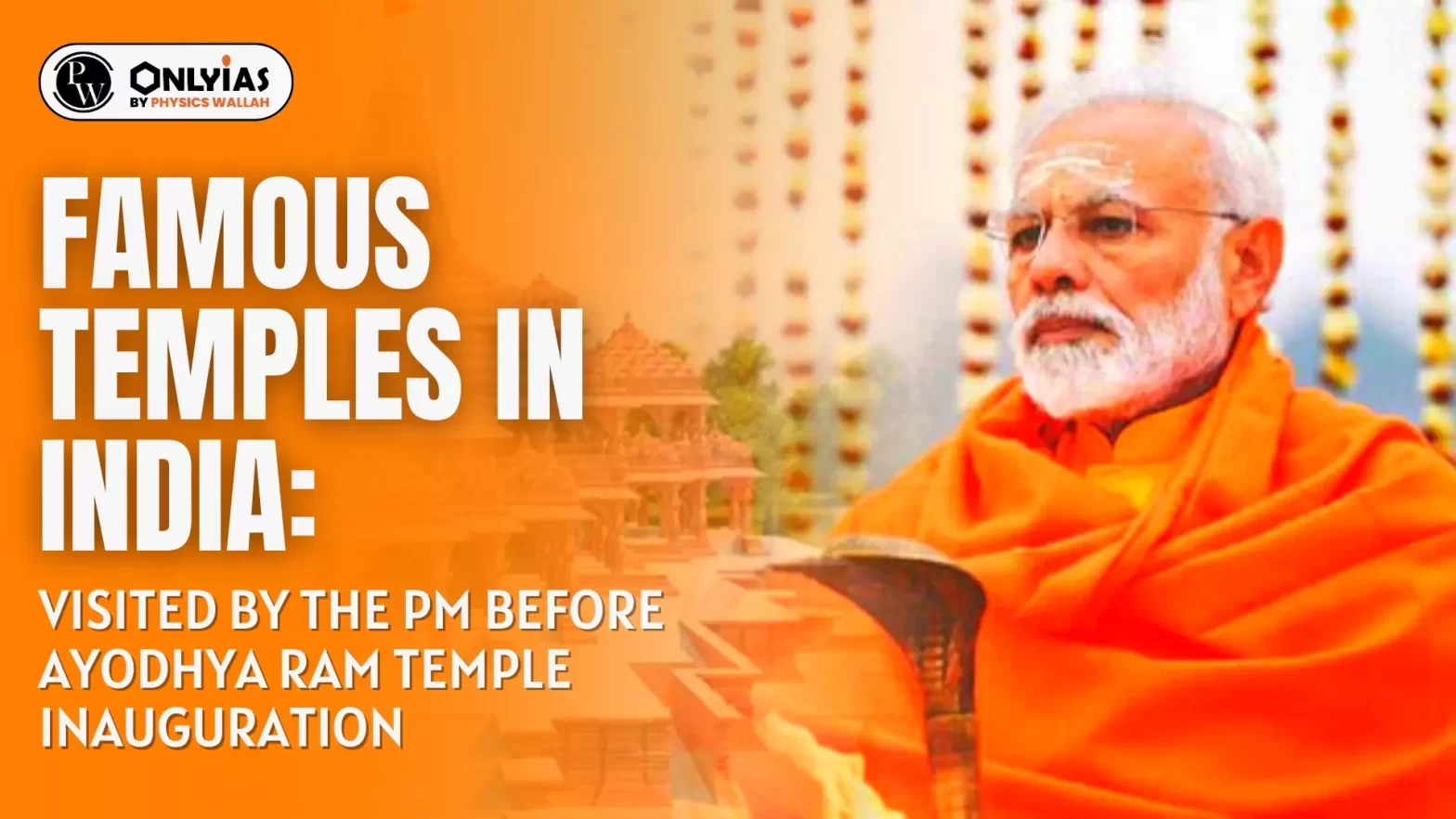
 Foundation of the Ram temple: It is built of a 14-metre-thick layer of roller-compacted concrete and a 21-foot-high granite plinth has been placed to protect against ground moisture.
Foundation of the Ram temple: It is built of a 14-metre-thick layer of roller-compacted concrete and a 21-foot-high granite plinth has been placed to protect against ground moisture.

 The image of Rama (Triprayar Thevar) resembles the Chaturbhuja Vishnu form with four arms, bearing a conch(Panchajanya), a disc (Sudarsana), a bow (Kodanda) and a garland respectively.
The image of Rama (Triprayar Thevar) resembles the Chaturbhuja Vishnu form with four arms, bearing a conch(Panchajanya), a disc (Sudarsana), a bow (Kodanda) and a garland respectively.

 Temple Construction: The temple was built in 1533 AD by Virupanna Nayaka and Vienna, who were governors under the Vijayanagar empire during the reign of king Achutaraya.
Temple Construction: The temple was built in 1533 AD by Virupanna Nayaka and Vienna, who were governors under the Vijayanagar empire during the reign of king Achutaraya.  The name Panchavati comes from the existence of five banyan trees in the area.
The name Panchavati comes from the existence of five banyan trees in the area. 

